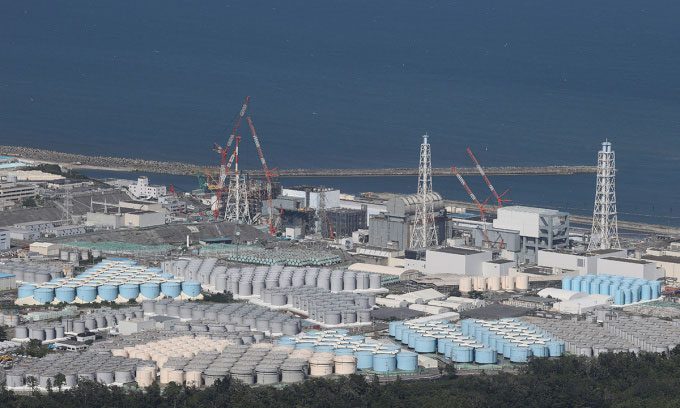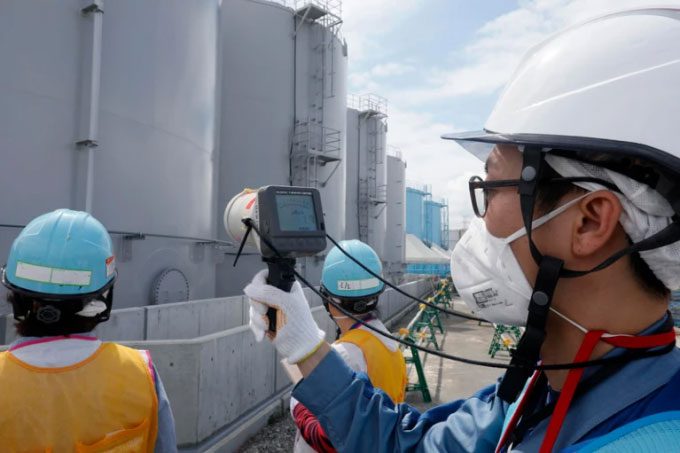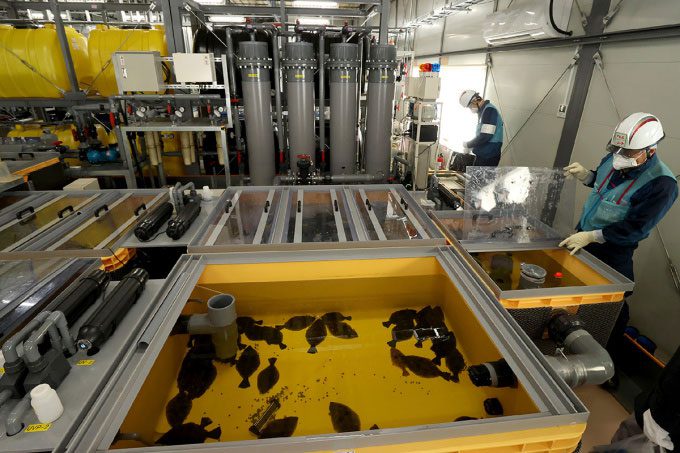The safety of treated wastewater from Fukushima, despite undergoing processing, remains a topic of debate due to the presence of radioactive isotopes such as carbon-14 and tritium.
Despite concerns from several countries and international organizations, Japan began discharging treated nuclear wastewater from the facility at 11 AM (Hanoi time) on August 24, releasing it through a one-kilometer underwater pipe into the sea. This water is the result of efforts to cool the damaged reactor cores after the Fukushima Daiichi nuclear power plant disaster caused by a severe earthquake and tsunami in 2011. As a result, water became contaminated with 64 radioactive isotopes. Some of these isotopes have relatively short half-lives and have decayed since the disaster occurred 12 years ago. However, others take much longer to decay; for example, carbon-14 has a half-life of over 5,000 years.

Treated water storage tanks at Fukushima Daiichi nuclear power plant as seen from above on August 24. (Photo: AFP).
Approximately 100,000 liters of contaminated water—comprising water used to cool the damaged reactors, groundwater, and rainwater runoff—are collected at the plant site each day. Authorities report that around 1.34 million tons, equivalent to nearly 540 Olympic-sized swimming pools, are currently stored in about 1,000 steel containers along the coast, with no remaining capacity.
The plant’s operator, Tokyo Electric Power Company (TEPCO), initiated the wastewater discharge when ocean conditions were stable and weather was favorable. TEPCO plans to release a total of 7,800 tons of water into the sea over the next 17 days, continuously 24 hours a day starting today. This is the first of four planned discharges for the 2023 fiscal year (from now until March 2024), with an expected total of 31,200 tons of water to be released.
According to TEPCO, they have employed the Advanced Liquid Processing System (ALPS) to treat the contaminated water through five stages, including co-precipitation, adsorption, and physical filtration. ALPS removed 62 of the 64 radioactive elements, bringing their concentrations below Japan’s 2022 regulatory limits for wastewater released into the environment. These limits are based on recommendations from the International Commission on Radiological Protection (ICRP).
However, this process does not eliminate carbon-14 and tritium, so the treated water still needs to be further diluted to below 1% of seawater. TEPCO reported that the concentration of tritium in the treated water is approximately 1,500 becquerels (a unit of radioactivity) per liter, which is about 1/7 of the World Health Organization’s (WHO) recommended level for tritium in drinking water.
According to the agency, tritium levels will decrease to naturally occurring levels under the sea within a few kilometers from the discharge site. The concentration of carbon-14 in the storage tanks is approximately 2% of the upper regulatory limit. This figure will further decrease due to the dilution with seawater before discharge.

TEPCO representatives measure radiation levels around the treated water storage tanks in 2018. (Photo: Kimimasa Mayama/AFP)
Contrasting Views
Countries like South Korea have expressed concerns that the treated water could have unforeseen impacts on the marine environment. Last year, the U.S. National Marine Laboratory Association also opposed the discharge plan, stating that there is a lack of comprehensive and accurate scientific data supporting Japan’s safety claims. The Philippine government has also urged Japan to reconsider the discharge into the Pacific Ocean.
Robert Richmond, a marine biologist at the University of Hawaii, along with other experts, reviewed all data provided by TEPCO and the Japanese government and visited the plant area but still identified several issues related to tritium and carbon-14.
While tritium is considered weak, it is still a beta-emitting substance, meaning it emits ionizing radiation which can damage DNA. TEPCO claims that the tritium concentration in the treated water emits a lower amount of ionizing radiation than what a person would be exposed to when flying round-trip from New York to Tokyo.
However, Richmond points out that human skin can partially shield against ionizing radiation. “If you eat something contaminated with beta-emitting radiation, the cells inside you will be exposed,” he stated.
Fishing activities do not occur frequently in the area 3 kilometers from the discharge pipe, according to TEPCO. However, Richmond is concerned that tritium could accumulate in the food web as larger organisms consume smaller radioactive organisms.
Organic-bound tritium may accumulate in fish and marine organisms, according to Shigeyoshi Otosaka, a marine chemist at the Atmosphere and Ocean Research Institute of the University of Tokyo. “I believe it is crucial to assess the long-term impacts of radioactive isotopes on the environment,” Otosaka remarked.

Flounder raised in treated water tanks from Fukushima Daiichi nuclear power plant on January 30. (Photo: Jiji Press/AFP)
TEPCO has conducted tests raising marine organisms in seawater containing ALPS-treated water. “We confirmed that the tritium concentration in marine organisms reaches a state of equilibrium after a certain period and does not exceed the concentration in their habitat,” a TEPCO spokesperson stated. The tritium concentration then gradually decreases over time as the organisms are returned to the seawater.
TEPCO, the Nuclear Regulation Authority of Japan, and the International Atomic Energy Agency (IAEA) will continuously monitor marine organisms and sediments around the discharge area.
Jim Smith, an environmental scientist at the University of Portsmouth, believes the risks of discharging water to Pacific Rim countries may be negligible. “I hesitate to say it’s zero, but it’s almost zero. The nearest island in the Pacific is about 2,000 kilometers away,” he stated.
Smith argues that keeping the treated water on-site poses a greater risk. “The risk of an earthquake or another storm causing a leak from the storage tanks is even higher, and they are running out of storage capacity,” he noted.



















































